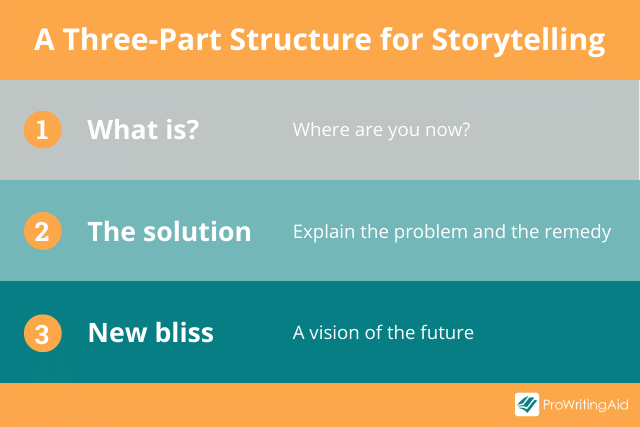
Anyone who’s ever been a leader, manager, coach, or teacher can tell you that motivating people is one of the hardest things about leading people.
You might have sales goals that you want your team to hit, or you want them to buy into a particular mission for the company—yet getting them to meet those sales goals, or embrace the mission, is both art and science.
That’s why storytelling, which is also a mix of art and science, is such a powerful tool in a leader’s communication toolkit. Leaders need to be skilled storytellers so that audiences can both remember and retell their key messages.
Stories are memorable and retellable because they transform information into something meaningful, understandable, and actionable for people.
The Power of Storytelling
Most of us have sat through hundreds of PowerPoint presentations and have arguably little to show for it—we can’t remember really anything that the presenters in that meeting were communicating to us.
But somehow we can remember stories from childhood, or a story that someone told us in college, or the story of how a particular company was founded.
We recall stories, in part, because of how they work in our brains. When we listen to a story, our brains produce oxytocin, a neurochemical that signals to us we can trust the person telling the story. That trust helps us create an emotional connection to the story and makes it more significant in our memories.
Stories work on us because they lighten our cognitive load. A story creates a meaningful structure, or category, around an idea, and our brains don't have to work as hard because we, the audience, don’t have to categorize that idea.
Instead, the storyteller has done the categorizing for us so we can pay attention to the subject of the story. In fact, research shows we are 12 times more likely to remember information when conveyed through a story.
The Three-Part Story
Clearly, stories are a critical tool in the leader’s communication toolbox. But a leader can’t just drag out an old personal story and then somehow try to link that story to their key message.
Instead, a leader really needs to think about developing a story around the following three-part structure:

Keep reading to learn more about those three parts, and to see how they work in a real story.
Part 1: What is?
In other words, where are you now? What is the current state of your business or product?
For someone to buy into a proposal, an idea, or a strategy, they must understand how this new idea will change the status quo. Your story must thoroughly answer the classic "So What?" question.
How do you do this?
First, make sure your reader knows where things currently stand.
Answer the following questions at the beginning of your story:
- Where are we at right now?
- What’s going on?
- What is the problem with the current situation?
It is key that you get your audience to see the issue in the same way that you do.
This sets up them up to fully understand parts two and three: the solution and new bliss.
Part 2: The solution
In part 1, you educate the reader on the issue so they understand what’s going on and what the problem is.
In part 2, you clearly articulate a solution to those problems you set out in part 1. Then, you explain how that solution actually solves the problem.
Don't skip the explanation. If the reader doesn’t understand how the solution works to solve the problem, they could abandon your entire story.
Part 3: New bliss
Many communicators get through parts 1 and 2, but fall at the last hurdle.
Part 3 is critical because it gives the reader a vision of what life would look like if they implement the solution you've suggested.
Nancy Duarte, one of the world’s leading business communication consultants, calls this stage "new bliss."
Here, you present a picture of the future that is so good that readers won’t want to give up that vision. They have no choice but to buy into the solution you have set out.
More of a visual learner?
Learn how to become a storyteller at work with this training video:
Example: Introducing New Software at Work
How do we put these parts together? Let's look at an example.
Sandra is the CEO of a 50-person digital marketing firm called Aesthetix. She’s found that their current methods of communicating, sharing information, and working collaboratively aren’t working.
To solve this, she is asking the entire firm to transition to a new knowledge management system called Shair.
It’s a big ask because most employees are so familiar with email and MS Office, and she knows not everyone is going to be okay with the transition.
An ineffective way of transitioning to the new system would be to just tell people, "Starting Monday, we will switch to a new system and we need everyone to use it."
Instead, she could tell a powerful story in an email or presentation.
Let’s look at how Sandra can communicate her idea using storytelling.
Example Stage 1: What is?
First, I want to thank everyone for their tireless efforts. We are thriving as a company and have increased revenues over 50% from last year. And yet I know we can achieve more.
Last month, I worked with our business development team on a pitch to a potentially amazing and long-term client in the health care industry. We worked all night to craft and polish the proposal, and we were all struck by one thing—how inefficient our information sharing processes were.
We realized that we scatter key documents and data all over the place, and we often weren’t sure who had the most up-to-date document.
All of us agreed that these inefficiencies slowed us down, and while we think we crafted a great proposal, it’s clear we need to address this challenge.
Example Stage 2: The solution
The day after we pitched that proposal, I created a task force to study how we might improve our information management systems and create more fluid work streams within and across teams.
After some intensive research and benchmarking, the task force suggested we go with Shair, an information-sharing platform used by hundreds of companies across an array of industries.
We chose Shair not only for cost, but because we believe they share our values, are committed to helping us learn how to use the product, and will enable us to customize it.
Example Stage 3: New bliss
In three months, we imagine how we work will look dramatically different. If you’re working on a proposal, you’ll have frictionless access to all documents and resources associated with that proposal.
No longer will you have to ask someone to send you an excel spreadsheet, or to email you minutes from a meeting. Instead, all of this information will be organized within Shair.
If someone is out of town, or on vacation, they won’t have to worry about whether someone has changed a document or have uploaded it—you’ll be able to see that in Shair.
Most importantly, we believe that in changing how we communicate and collaborate that we’ll become better communicators and collaborators.
See how helping people understand your perspective with a story makes it more interesting?
TL;DR
To recap:
- First, make sure your reader knows where things currently stand (problems and limitations).
- Then, clearly articulate a solution to those problems you set out in part 1.
- Finally, present a picture of the future that is so good that readers can't help but want to reach it.
Leaders like you are constantly communicating with a diverse set of stakeholders, so it’d be hard to apply this three-stage storifying process to every presentation, talk, or e-mail you produce.
But for high-stakes communications, where creating understandable and actionable information is critical, leaders should become storytellers wherever and whenever they can.
Do You Want To Make Sure Your Presentations Are Free From Errors?
ProWritingAid is free to use and will help detect spelling and grammar issues in your writing—it even works in PowerPoint. Try it for free today!

